| Pages:
1
..
36
37
38
39
40
..
68 |
Laboratory of Liptakov
International Hazard
    
Posts: 1447
Registered: 2-9-2014
Location: Tel Aviv University
Member Is Offline
Mood: old jew
|
|
packaging
Well! It looks good. I see that a lot of copper is annealed. That is good. I made a few more unsuccessful attempts. Attention. The packaging is very
important. It must be hard, preferably steel wall at least 2 mm thick. It is minimum. If the packaging is soft (plastic only) or weak (only Cu clutch
1mm), EFP does not work good. Use soft or weak packaging waste EM... ...LL ...LL
|
|
|
Hennig Brand
International Hazard
    
Posts: 1284
Registered: 7-6-2009
Member Is Offline
Mood: No Mood
|
|
Thanks, good to know about the casing requirements. I might try one more test before I go for stronger confinement anyway though.
What you are looking at in my last post is an old piece of copper plumbing pipe that was cut down the middle, lengthwise, and folded out. The black is
black copper oxide. Annealing probably would be a good idea though.
"A risk-free world is a very dull world, one from which we are apt to learn little of consequence." -Geerat Vermeij
|
|
|
Hennig Brand
International Hazard
    
Posts: 1284
Registered: 7-6-2009
Member Is Offline
Mood: No Mood
|
|
LL, are you anchoring the steel target? I have been just standing the target up and using a small spring clamp to steady it. Trying to decide if
anchoring the steel plate/target better would make much difference.
The following snip-it was taken from, "History of the Shaped Charge Effect - The First 100 Years", by Donald R. Kennedy. I thought it was kind of
interesting.
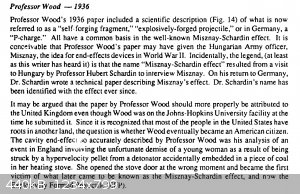
"A risk-free world is a very dull world, one from which we are apt to learn little of consequence." -Geerat Vermeij
|
|
|
Laboratory of Liptakov
International Hazard
    
Posts: 1447
Registered: 2-9-2014
Location: Tel Aviv University
Member Is Offline
Mood: old jew
|
|
gold sands
Henning, I know how attached the target. It is in the figures, the photo. If the target is large and heavy, so it's unimportant. The target may be in
the air or sand. This does not affect the result. If so, I guess only difference is 5%. Maximum 10% of the whole assembly sand versus air. The sand
will always be a little better results. And most importantly, it's safer. In particular, if the device is made of steel... ...LL ...LL
|
|
|
Hennig Brand
International Hazard
    
Posts: 1284
Registered: 7-6-2009
Member Is Offline
Mood: No Mood
|
|
I didn't try to work it out, at least not yet, but that is what I figured too. The diameter of the projectile is small and moving at very high
velocity and the target is relatively heavy (a lot of inertia).
Success with Conical (Munroe Effect) Shaped Charge
I bought some of the steel cones that Markx discussed earlier in this thread here:
http://www.sciencemadness.org/talk/viewthread.php?tid=10575&...
I got a half order of the 1"W X 1"H (~53 degree apex angle) UK cones that Markx was using and the other half in 1"W X 1/2"H (~90 degree apex angle) US
style cone studs. I used one of the 1" X 1/2" cones for my first test. An aluminum tube was bored out on the lathe so that it had an inside diameter
slightly larger than the cone with a lip left for the cone to sit on. A section of hardwood dowel was turned down, so that it would fit the aluminum
casing snugly. The wooden dowel section was also bored so that one end could accept safety fuse and the other end could have 0.15g LA, and 0.5g of
PETN pressed in. Plastic explosive was used (3g of 80% ETN/10% polybutene/10% mineral oil). The PETN was in direct contact with the plastic explosive
when the wooden bushing was put in place. Standoff used was 1.5 CD (charge diameter). Cone/liner diameter was ca. 1/2" (12.7mm). Charge diameter was
ca. 15mm.
The charge easily penetrated the 3/8" (ca. 9.5mm) steel plate. Hole diameter was ca. 4mm at entry and ca. 3.4mm at exit. I know Markx has already been
here with a similar type of charge, but it really is impressive how well these work. I feel I should have tried a thicker steel target, especially
since I see looking back that Markx penetrated 15mm of steel with the more acute angled cones of the same type.
I don't have a lot of pictures because I forgot my phone when leaving for the test site. I did take one before assembling the charge and a couple of
the target once I returned home.
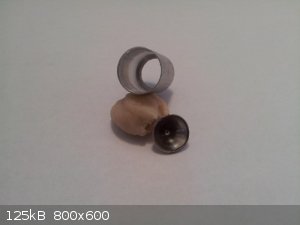
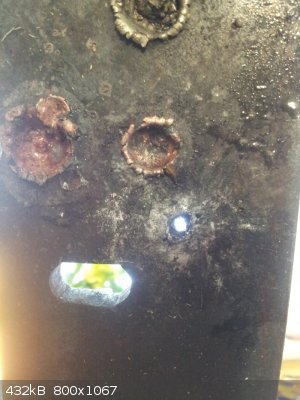 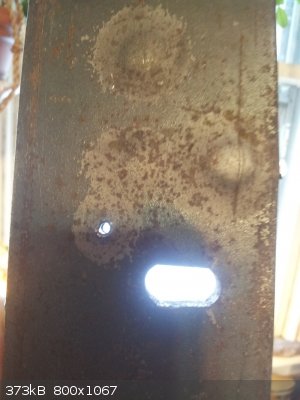
[Edited on 9-1-2015 by Hennig Brand]
"A risk-free world is a very dull world, one from which we are apt to learn little of consequence." -Geerat Vermeij
|
|
|
dangerous amateur
Hazard to Others
  
Posts: 148
Registered: 8-7-2011
Member Is Offline
Mood: No Mood
|
|
Do you have an opinion on EFPs based on rather slow explosives? Like AN or even Chlorate binaries?
When I tested such charges on metal witnes plates I found that often holes with charge diameter where punched, and the loose material hit the ground
with a lot of penetration power.
But the standoff was only 30mm or so. I wonder what would happen with the right standoff?
2500 or maybe 3000m per second is not hypervelocity, but maybe there will still be some kind of flowing or maybe forging of the metal into a
"penetrating something"?
|
|
|
Hennig Brand
International Hazard
    
Posts: 1284
Registered: 7-6-2009
Member Is Offline
Mood: No Mood
|
|
I don't have a lot of experience with it, but the literature indicates that those low velocity type explosives don't perform well in shaped charge
applications.
"A risk-free world is a very dull world, one from which we are apt to learn little of consequence." -Geerat Vermeij
|
|
|
Laboratory of Liptakov
International Hazard
    
Posts: 1447
Registered: 2-9-2014
Location: Tel Aviv University
Member Is Offline
Mood: old jew
|
|
cone 84
For deep penetration cumulative effect better is VoD + 6000 m/s. For EFP + 7000 m/s. (for quality efects). Use of plastic / copper / for the SC
device. Construction steel 30mm / 1.18 inch. Inclined cone a few degrees. This is the error impact on the TOP... ...LL ...LL
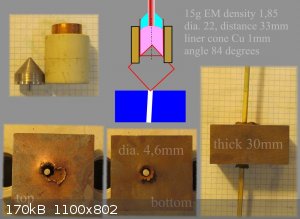
|
|
|
Hennig Brand
International Hazard
    
Posts: 1284
Registered: 7-6-2009
Member Is Offline
Mood: No Mood
|
|
That was a nice result you got there. I am anxious to try again with one of those little steel cones on a thicker piece of steel. I am looking at a
piece of 3/4" (~19mm) steel plate right now which might just be the next victim. 
"A risk-free world is a very dull world, one from which we are apt to learn little of consequence." -Geerat Vermeij
|
|
|
Laboratory of Liptakov
International Hazard
    
Posts: 1447
Registered: 2-9-2014
Location: Tel Aviv University
Member Is Offline
Mood: old jew
|
|
armor
Amateur human mind is difficult to understand how this is possible. A piece of soft copper pierces thick armor. Unbelievable. But it works ... ...LL ...LL
|
|
|
Hennig Brand
International Hazard
    
Posts: 1284
Registered: 7-6-2009
Member Is Offline
Mood: No Mood
|
|
It is very amazing that it works, yes. Steel, and other materials also, behaves very differently when subjected to very high velocities and pressures.
"A risk-free world is a very dull world, one from which we are apt to learn little of consequence." -Geerat Vermeij
|
|
|
markx
National Hazard
   
Posts: 650
Registered: 7-8-2003
Location: Northern kingdom
Member Is Offline
Mood: Very Jolly
|
|
Quote: Originally posted by Hennig Brand  | I am anxious to try again with one of those little steel cones on a thicker piece of steel. I am looking at a piece of 3/4" (~19mm) steel plate right
now which might just be the next victim.  |
These little buggers really leave a mark, don't they  For 19mm steel plate I
would suggest charge masses upwards of 5g (more likely 7-9g of nitroester/nitramine base for a clean penetration with mediocre confinement and
presicion). For 19mm steel plate I
would suggest charge masses upwards of 5g (more likely 7-9g of nitroester/nitramine base for a clean penetration with mediocre confinement and
presicion).
Really excellent work on the steel plate btw! Very clean uniform penetration, no deflection or divided jet patterns. Looking forward to the test
results with 19mm plate 
Exact science is a figment of imagination.......
|
|
|
Bert
Super Administrator
        
Posts: 2821
Registered: 12-3-2004
Member Is Offline
Mood: " I think we are all going to die. I think that love is an illusion. We are flawed, my darling".
|
|
A long time back, in high school, I combined some of my metal working shop and art class projects- I tried making my own Copper blanks and then
enameling these, besides other metal jewelry work. Never considered back then, I could have added some of my organic chemistry extra curricular
activities to those projects? Probably not with instructor approval though.
I always wanted some of the nicer specialty tools for small metal working jobs...
Like these precision punches
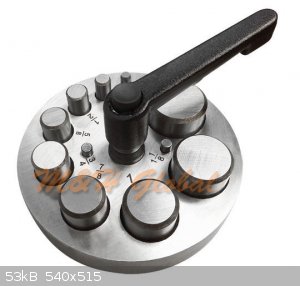
Or this set which also makes concave/convex discs...
Even if the profile wasn't exactly correct, a little free hand work with a diamond home on a punch mounted in drill press chuck could be done to alter
such punches.
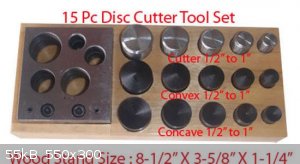
I am a tool slut.
[Edited on 9-1-2015 by Bert]
Rapopart’s Rules for critical commentary:
1. Attempt to re-express your target’s position so clearly, vividly and fairly that your target says: “Thanks, I wish I’d thought of putting it
that way.”
2. List any points of agreement (especially if they are not matters of general or widespread agreement).
3. Mention anything you have learned from your target.
4. Only then are you permitted to say so much as a word of rebuttal or criticism.
Anatol Rapoport was a Russian-born American mathematical psychologist (1911-2007).
|
|
|
markx
National Hazard
   
Posts: 650
Registered: 7-8-2003
Location: Northern kingdom
Member Is Offline
Mood: Very Jolly
|
|
Here's the results of a 7g phlegmatized (10% PIB+methyl riccinoleate) PETN charge on 15mm steel plate:
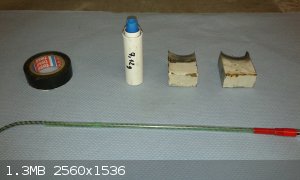 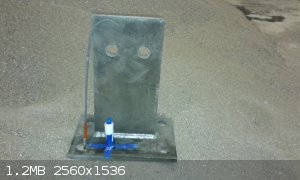
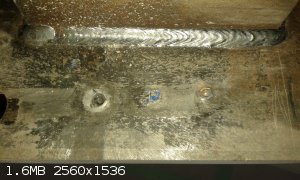 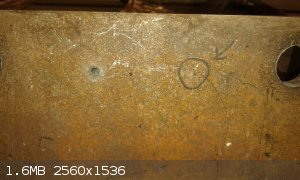 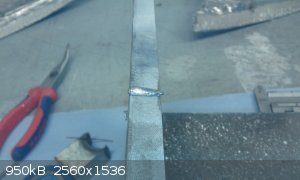 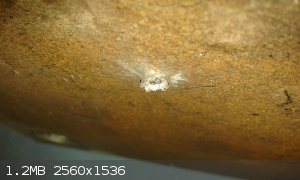
I managed to recover the carrot...what a blessed find....the bastard was stuck at the outer exiting verge of the crater 
I guess just 100mg more energetic would have sufficed and it would have left the target to never be found again.
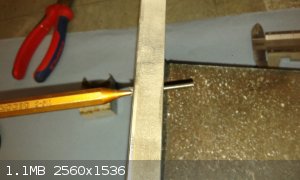
[Edited on 9-1-2015 by markx]
Exact science is a figment of imagination.......
|
|
|
Bert
Super Administrator
        
Posts: 2821
Registered: 12-3-2004
Member Is Offline
Mood: " I think we are all going to die. I think that love is an illusion. We are flawed, my darling".
|
|
Such a cute little hole punch.
It would be really nice to include a scale with such pictures, or use a piece of graph paper of a specified size for the background?
Rapopart’s Rules for critical commentary:
1. Attempt to re-express your target’s position so clearly, vividly and fairly that your target says: “Thanks, I wish I’d thought of putting it
that way.”
2. List any points of agreement (especially if they are not matters of general or widespread agreement).
3. Mention anything you have learned from your target.
4. Only then are you permitted to say so much as a word of rebuttal or criticism.
Anatol Rapoport was a Russian-born American mathematical psychologist (1911-2007).
|
|
|
markx
National Hazard
   
Posts: 650
Registered: 7-8-2003
Location: Northern kingdom
Member Is Offline
Mood: Very Jolly
|
|
Quote: Originally posted by Bert  | Such a cute little hole punch.
It would be really nice to include a scale with such pictures, or use a piece of graph paper of a specified size for the background?
|
I know, I know....I stand ashamed, facing multiple accusations of chronical incapabablity to include a proper scale reference in the graphical
evidence of experimental results. But I was having just too much fun and the excitement of success can do weird things to ones' judgement for
executing the correct scientifical method
In light of this the reported thickness of the plate can be viewed as anecdotal reference and I have no intention to file an appeal on the matter.
I promise to correct my wicked ways in future reports 
Exact science is a figment of imagination.......
|
|
|
Fulmen
International Hazard
    
Posts: 1749
Registered: 24-9-2005
Member Is Offline
Mood: Bored
|
|
But it's hard, isn't it? Doing the experiment is fun, even measuring the result is fun. But to document things properly, that's actually hard work. At
least it is for me, and I suspect I'm not the only one. I think we owe our self to push each other, not only to do good note-keeping but also to share
our work with enough detail so that others can replicate it. That's what science is all about really.
Other than that little derailment, I just wanted to say: Keep up the good work! I love reading about them, all the cool experiments you do.
I'm seriously considering revisiting my experiments with drawing liners, especially now that I have my furnace working. Sadly I have so much on my
plate I can barely focus on the things I <i>have</i> to do even though it's my own projects that keep me going. I don't have time to do a
write-up, but if others are looking into this route I'm sure I could offer up some advice.
This of course requires access to a lathe and quite a bit of theory, I have a PDF of "Handbook of Die Design", second edition from McGraw-Hill that
was quite useful there. Don't know where I got it from but I'm sure you will find it if you search.
|
|
|
Hennig Brand
International Hazard
    
Posts: 1284
Registered: 7-6-2009
Member Is Offline
Mood: No Mood
|
|
Nice work Markx. I like those cutters and dies Bert, but I think I am going to make one on the lathe to start. I think most of my problems have been
because of asymmetrical liners, which may be what you were picking up on.
Yes Fulmen, the research, the experimentation and the documentation all take work. Most things done of any significance take work. People who do the
work generally don't like to be belittled. We have been getting a look at LL's greatest hits, which is nice and I appreciate it, but there is maybe as
much or even more to learn from some of the things others did (like myself) where things didn't go perfectly.
[Edited on 9-1-2015 by Hennig Brand]
"A risk-free world is a very dull world, one from which we are apt to learn little of consequence." -Geerat Vermeij
|
|
|
Fulmen
International Hazard
    
Posts: 1749
Registered: 24-9-2005
Member Is Offline
Mood: Bored
|
|
Access to a lathe greatly improves your chances. Accuracy, not only in the manufacture of the liner but equally in the assembly greatly affects
performance. If you can, make tools for the assembly as well. As always, the more effort you put into something the more you can expect in return. I
suspect EFPs are somewhat more forgiving in this aspect.
|
|
|
NeonPulse
Hazard to Others
  
Posts: 417
Registered: 29-6-2013
Location: The other end of the internet.
Member Is Offline
Mood: Isolated from Reality! For Real this time....
|
|
I agree hennig, for all our successes how many failures have we had? I know I tested at least 10 charges before I got any significant penetration nd
these failures are what presses us to try again. If we got it perfect first go then where is the incentive to keep researching? Keep it up guys this
is a great thread and its great to see it revived. In the near future I plan to attempt some EFP devices for myself. Its been a while since my last SC
test and have found some nice old AUS pennies to try. They are copper only and 1.8mm thick. getting other factors right they should work well. Also
hennig did you aim the efp somehow? Like a laser dot from the center of the charge and a mark on the target to match, just to see how far off supposed
center the projectile strikes? If it hits close to the prediction then increased standoff should not be a worry with missing the target. NP
|
|
|
Hennig Brand
International Hazard
    
Posts: 1284
Registered: 7-6-2009
Member Is Offline
Mood: No Mood
|
|
Glad to hear you are enjoying the thread. Regarding aiming an EFP, I was on rough ground, but the target and charge were both placed on a piece of
plywood, which was relatively flat, which lined them up. A carpenters square can be used to make sure the charge is parallel to the wood rest and
perpendicular to the target. The target and charge can be placed close together to ensure that they are lined up at the right height and then pulled
apart to the desired standoff. Once at the right standoff I literally lied down on the ground behind the charge and sighted the EFP in by looking down
the top of the charge casing. It is amazing how well the EFP can be aimed by sighting down the casing. A laser level would likely be a great way to
line up an EFP with a target.
"A risk-free world is a very dull world, one from which we are apt to learn little of consequence." -Geerat Vermeij
|
|
|
Laboratory of Liptakov
International Hazard
    
Posts: 1447
Registered: 2-9-2014
Location: Tel Aviv University
Member Is Offline
Mood: old jew
|
|
smart container
Using polystyrene container is very easy. Production takes 20 minutes. The entire device buries itself in the sand. EFP warhead can be very precisely
adjusted. At the right angle 90x90 deg. Easy, cheap, fast. Safe. For the brave hero (for video) Needless to bury... ...LL ...LL
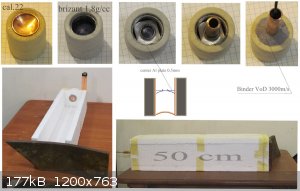
|
|
|
Bert
Super Administrator
        
Posts: 2821
Registered: 12-3-2004
Member Is Offline
Mood: " I think we are all going to die. I think that love is an illusion. We are flawed, my darling".
|
|
You are using the plasticized perchlorate explosive described elsewhere as a an "active" backing plate/counter charge on the side of propelling charge
opposite the EFP?
Thanks for the graph paper background! What size are the squares?
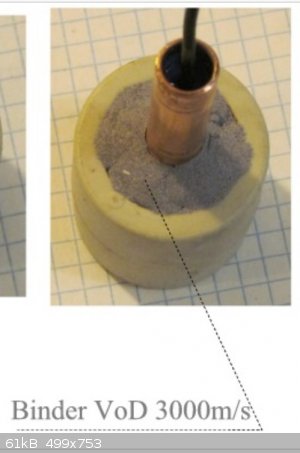
[Edited on 11-1-2015 by Bert]
Rapopart’s Rules for critical commentary:
1. Attempt to re-express your target’s position so clearly, vividly and fairly that your target says: “Thanks, I wish I’d thought of putting it
that way.”
2. List any points of agreement (especially if they are not matters of general or widespread agreement).
3. Mention anything you have learned from your target.
4. Only then are you permitted to say so much as a word of rebuttal or criticism.
Anatol Rapoport was a Russian-born American mathematical psychologist (1911-2007).
|
|
|
Laboratory of Liptakov
International Hazard
    
Posts: 1447
Registered: 2-9-2014
Location: Tel Aviv University
Member Is Offline
Mood: old jew
|
|
steel 12
Yes, slow plastic explosive is described in the thread cheddite, pag. 7, title AP plastic. Squares on the paper are 5x5mm. The mass used around 4g.
Slow AP plastic as an active supporting plate. The detonation propagates in two directions. Thus it is meant. Here are the results of this report.
Unfortunately, the device was not accurate. I do not know where the error is. Everything was made very accurately. EFP-quality effect is difficult to
create. Despite this, 12 mm steel shot through. Although little, but still... ..LL ..LL
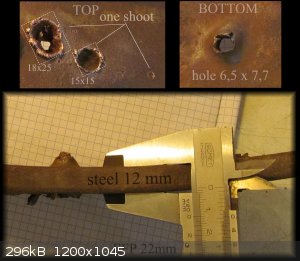
|
|
|
markx
National Hazard
   
Posts: 650
Registered: 7-8-2003
Location: Northern kingdom
Member Is Offline
Mood: Very Jolly
|
|
Congratulations! Excellent results LL! Now this impact looks more like the projectile had time and space to form into a rather decent slug. It also
looks like the projectile parted or perhaps it is the impact of the separation plate that you had between the main charge and the backcharge. I guess
the root cause of the partitions lies in the overcomplicated design of the separated charges. The separation plate, the copper tube through it coupled
with the initiator....all this creates quite a mess at the back end of the main "brizant" charge when fired and can possibly do more harm than good to
the overall performance of the device (by disrupting the uniform propagation of detonation wave in the main charge)
If one could embed a centrally placed initator between the main and backing charge in direct contact with both of them and with no penetrating
channels through the backing charge then I think this concept might work magnificent. Technically very demanding task though...
Exact science is a figment of imagination.......
|
|
|
| Pages:
1
..
36
37
38
39
40
..
68 |